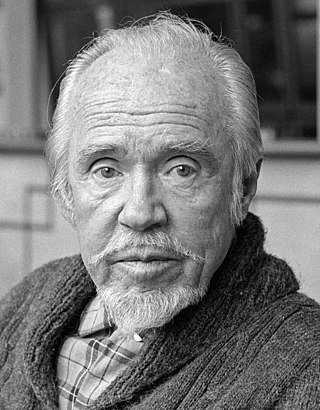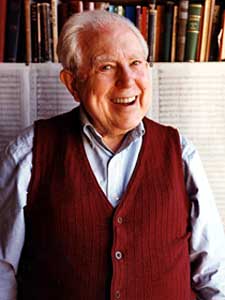Related Research Articles
The time signature is a notational convention used in Western musical notation to specify how many beats (pulses) are contained in each measure (bar), and which note value is equivalent to a beat.
In musical terminology, tempo is the speed or pace of a given piece. In classical music, tempo is typically indicated with an instruction at the start of a piece and is usually measured in beats per minute. In modern classical compositions, a "metronome mark" in beats per minute may supplement or replace the normal tempo marking, while in modern genres like electronic dance music, tempo will typically simply be stated in BPM.

Charles Edward Ives was an American modernist composer, one of the first American composers of international renown. His music was largely ignored during his early career, and many of his works went unperformed for many years. Later in life, the quality of his music was publicly recognized through the efforts of contemporaries like Henry Cowell and Lou Harrison, and he came to be regarded as an "American original". He was also among the first composers to engage in a systematic program of experimental music, with musical techniques including polytonality, polyrhythm, tone clusters, aleatory elements, and quarter tones. His experimentation foreshadowed many musical innovations that were later more widely adopted during the 20th century. Hence, he is often regarded as the leading American composer of art music of the 20th century.

Henry Dixon Cowell was an American composer, writer, pianist, publisher and teacher. Earning a reputation as an extremely controversial performer and eccentric composer, Cowell became a leading figure of American avant-garde music for the first half of the 20th century — his writings and music serving as a great influence to similar artists at the time, including Lou Harrison, George Antheil, and John Cage, among others. He is considered one of America's most important and influential composers.

A metronome, from ancient Greek μέτρον and νομός is a device that produces an audible click or other sound at a regular interval that can be set by the user, typically in beats per minute (BPM). Metronomes may include synchronized visual motion. Musicians use the device to practise playing to a regular pulse.

Samuel Conlon Nancarrow was an American-Mexican composer who lived and worked in Mexico for most of his life. Nancarrow is best remembered for his Studies for Player Piano, being one of the first composers to use auto-playing musical instruments, realizing their potential to play far beyond human performance ability. He lived most of his life in relative isolation and did not become widely known until the 1980s.

Polyrhythm is the simultaneous use of two or more rhythms that are not readily perceived as deriving from one another, or as simple manifestations of the same meter. The rhythmic layers may be the basis of an entire piece of music (cross-rhythm), or a momentary section. Polyrhythms can be distinguished from irrational rhythms, which can occur within the context of a single part; polyrhythms require at least two rhythms to be played concurrently, one of which is typically an irrational rhythm. Concurrently in this context means within the same rhythmic cycle. The underlying pulse, whether explicit or implicit can be considered one of the concurrent rhythms. For example, the son clave is poly-rhythmic because its 3 section suggests a different meter from the pulse of the entire pattern.

Elliott Cook Carter Jr. was an American modernist composer. One of the most respected composers of the second half of the 20th century, he combined elements of European modernism and American "ultra-modernism" into a distinctive style with a personal harmonic and rhythmic language, after an early neoclassical phase. His compositions are performed throughout the world, and include orchestral, chamber music, solo instrumental, and vocal works. The recipient of many awards, Carter was twice awarded the Pulitzer Prize.

In music, tape loops are loops of magnetic tape used to create repetitive, rhythmic musical patterns or dense layers of sound when played on a tape recorder. Originating in the 1940s with the work of Pierre Schaeffer, they were used among contemporary composers of 1950s and 1960s, such as Éliane Radigue, Steve Reich, Terry Riley, and Karlheinz Stockhausen, who used them to create phase patterns, rhythms, textures, and timbres. Popular music authors of 1960s and 1970s, particularly in psychedelic, progressive and ambient genres, used tape loops to accompany their music with innovative sound effects. In the 1980s, analog audio and tape loops with it gave way to digital audio and application of computers to generate and process sound.

Process music is music that arises from a process. It may make that process audible to the listener, or the process may be concealed.

Kyle Eugene Gann is an American professor of music, critic, analyst, and composer who has worked primarily in the New York City area. As a music critic for The Village Voice and other publications, he has supported progressive music, including such "downtown" movements as postminimalism and totalism.
A tone cluster is a musical chord comprising at least three adjacent tones in a scale. Prototypical tone clusters are based on the chromatic scale and are separated by semitones. For instance, three adjacent piano keys struck simultaneously produce a tone cluster. Variants of the tone cluster include chords comprising adjacent tones separated diatonically, pentatonically, or microtonally. On the piano, such clusters often involve the simultaneous striking of neighboring white or black keys.
Violin Phase is a musical work written by minimalist composer Steve Reich in October 1967.
The Desert Music is a work of music for voices and orchestra composed by the minimalist composer Steve Reich. It is based on texts by William Carlos Williams and takes its title from the poetry anthology The Desert Music and Other Poems. The composition consists of five movements, with a duration of about 46 minutes. In both its arrangement of thematic material and use of tempi, the piece is in a characteristic arch form (ABCBA). The piece was composed in 1983 and had its world premiere on 17 March 1984 in Cologne, Germany.

Wallingford Constantine Riegger was an American modernist composer and pianist, best known for his orchestral and modern dance music. He was born in Albany, Georgia, but spent most of his career in New York City, helping elevate the status of other American composers such as Charles Ives and Henry Cowell. Riegger is noted for being one of the first American composers to use a form of serialism and the twelve-tone technique.
The Rhythmicon—also known as the Polyrhythmophone—was an electro-mechanical musical instrument designed and built by Leon Theremin for composer Henry Cowell, intended to reveal connections between rhythms, pitches and the harmonic series. It used a series of perforated spinning disks, similar to a Nipkow disk, to interrupt the flow of light between bulbs and phototoreceptors aligned with the disk perforations. The interrupted signals created oscillations which were perceived as rhythms or tones depending on the speed of the disks. Although it generated both pitches and rhythms, it has often been described as the world's first drum machine.
American Berserk is a short composition for solo piano by the American composer John Adams. The work was commissioned by the Carnegie Hall Corporation for the pianist Garrick Ohlsson, to whom the piece is dedicated. The first performance took place on February 25, 2002, at Carnegie Hall, New York City, with Ohlsson on the piano.

Phase music is a form of music that uses phasing as a primary compositional process. It is an approach to musical composition that is often associated with minimal music, as it shares similar characteristics, but some commentators prefer to treat phase music as a separate category. Phasing is a compositional technique in which the same part is played on two musical instruments, in steady but not identical tempi. Thus, the two instruments gradually shift out of unison, creating first a slight echo as one instrument plays a little behind the other, then a doubling effect with each note heard twice, then a complex ringing effect, and eventually coming back through doubling and echo into unison. Phasing is the rhythmic equivalent of cycling through the phase of two waveforms as in phasing. Note that the tempi of the two instruments are almost identical, so that both parts are perceived as being in the same tempo: the changes only separate the parts gradually. In some cases, especially live performance where gradual separation is extremely difficult, phasing is accomplished by periodically inserting an extra note into the phrase of one of the two players playing the same repeated phrase, thus shifting the phase by a single beat at a time, rather than gradually.

The Studies for Player Piano is a series of 49 études for player piano by American composer Conlon Nancarrow. Often exploring complex rhythmic variations beyond the ability of a human pianist, these compositions are some of the best-known and celebrated compositions by Nancarrow, even though they are generally not considered a set of compositions, but rather individual compositions that were given the same title and status. The dates of composition are unknown, but approximate ranges have been given according to best evidence.

Black MIDI is a music genre consisting of compositions that use MIDI files to create a song or a remix containing a large number of notes, typically in the thousands, millions, billions, or even trillions. People who make black MIDIs are known as blackers. However, there are no specific criteria of what is considered "black"; as a result, pinpointing the exact origin of black MIDI is impossible.
References
- ↑ Collections of articles; Greschak, John
- ↑ Henry Cowell, With contributions by David Nicholls, New Musical Resources, [ page needed ], Cambridge University Press, 1996 (original text by Henry Cowell published in 1930), ISBN 978-0-521-49974-3
- ↑ Valerio Camporini F., Multitemporal Designs, (Line)